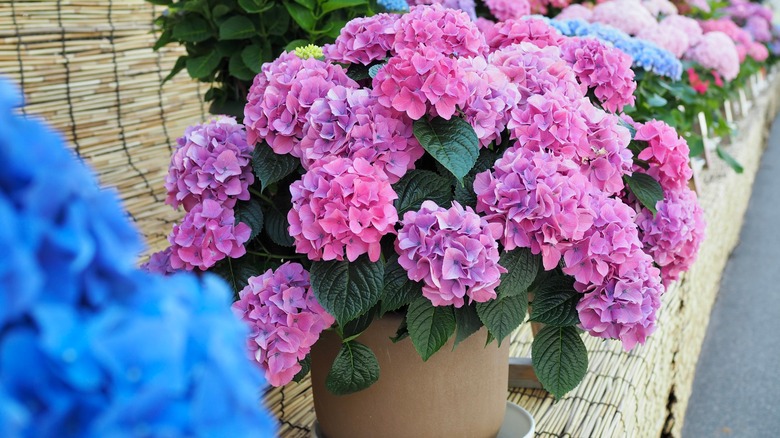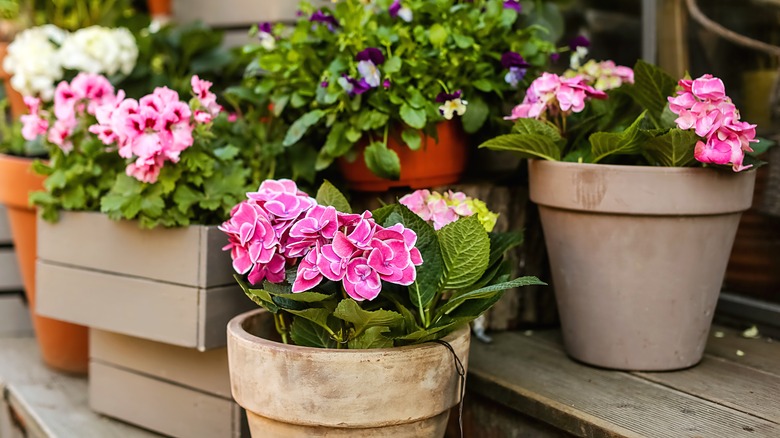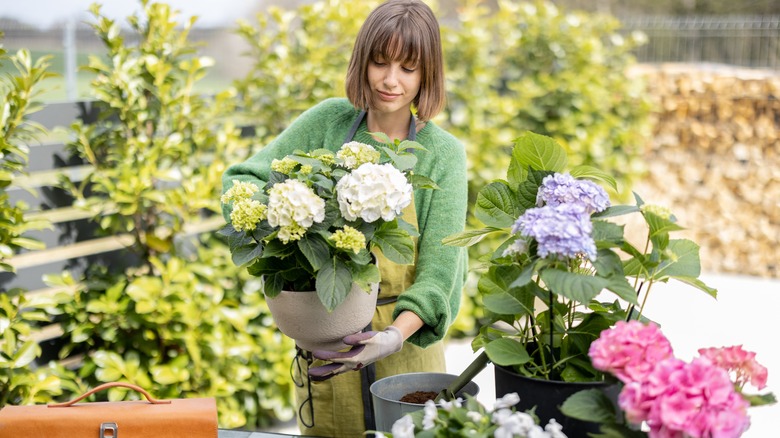A Garden Expert Explains The Best Type Of Pot For Flourishing Hydrangeas
Container gardening is a beloved phenomenon that has allowed plant lovers with little outdoor space to produce flourishing gardens. Whether it's due to apartment living that gives you no more than a balcony to work with, or a townhome with a tiny yard that's primarily concrete anyway, you can still grow all kinds of plants and crops. Hydrangeas, particularly, are one easy-to-grow flower that can thrive in pots and will brighten up your home. The shrub is native to Asia and parts of North America, growing up to 15 feet tall when planted in the ground and still reaching a 6-foot height when potted, depending on the variety.
Loved for its colorful variety of circular-clustered flowers in shades of pinks, blues, purples, whites, and greens, you can add it to your front steps this summer by learning which pots and conditions encourage hydrangeas' growth. Garden journalist and expert John Negus tells Homes and Gardens that fertile, "slow to dry out," and loamy soil is essential to hydrangea's health. This potted shrub should also have a large enough container for the roots to spread freely, along with consistent watering. Additionally, you'll want to keep your weather in mind, decide if the pot is a temporary or permanent situation, and consider what potting materials will enhance or possibly hinder the success of your hydrangeas.
The best pot for your hydrangeas
Hydrangeas aren't known to be picky flowers; however, when it comes to potting them, there are certainly ways you can stimulate a healthy and beneficial environment. Gardening expert John Negus explained to Homes and Gardens that the perennials aren't "fussy about the pH of their soil, but the soil does need to be fertile, well fed, and slow to dry out." Negus recommends using a compost combination with plenty of loam since hydrangeas love aerated mixes. Additionally, it's essential never to reuse potting mix or soil as it will have high water retention that hydrangeas can't handle.
Hydrangeas grow quite big and fast, so set yourself up for success by starting with a pot of 24 inches or larger. Small or medium receptacles will require repotting within two years. If you're planning to keep your hydrangeas in a container for only one season, then a medium pot isn't such an issue. A temporary placement will offer more flexibility on the kind of pot you use, as it will only be resting there for a short time. For permanent locations, you'll want a larger pot and to steer clear of any clay, terracotta, or ceramic materials if you experience harsh winters. You may also want to keep in mind the weight of your container on the possibility you'll need to move it around. In that case, a lighter-weight pot will be more efficient, but heavier ones can also be placed on stands with wheels for convenience.
How to pot hydrangeas
Potting your hydrangeas is a fairly easy process, with its success riding primarily on using the correct soil and offering it the right amount of sunlight and shade. Hydrangeas are not overly sensitive to their growing conditions but should have a potting mix with a pH of around 5.5. While they can grow well in most soil types, they prefer well-draining and sandy soils. But they will usually flourish as long as they get plenty of drainage, regardless of if their pH is a little off. A partially sunny and shady location will be a perfect spot for your pots and hydrangeas; needing plenty of sunlight but still prefer partial shade. Different flower colors also can prefer different kinds of dirt. Blues tend to do best in acidic soils, and pinks in alkaline.
After preparing the potting soil, you'll want to add fertilizer as you plant your hydrangeas. All-purpose and slow-release fertilizers work great, but any compost/organic matter will also do the trick. Make sure to free any bound roots and place them in the pot at the same height as they were in their nursery container. Not planting them too deep will allow the roots ample room to spread out and grow. Try to leave a few inches of room near the rim of the planter for watering space, and don't forget to prune as they bloom. With these steps, you'll see your hydrangeas prosper in no time.


